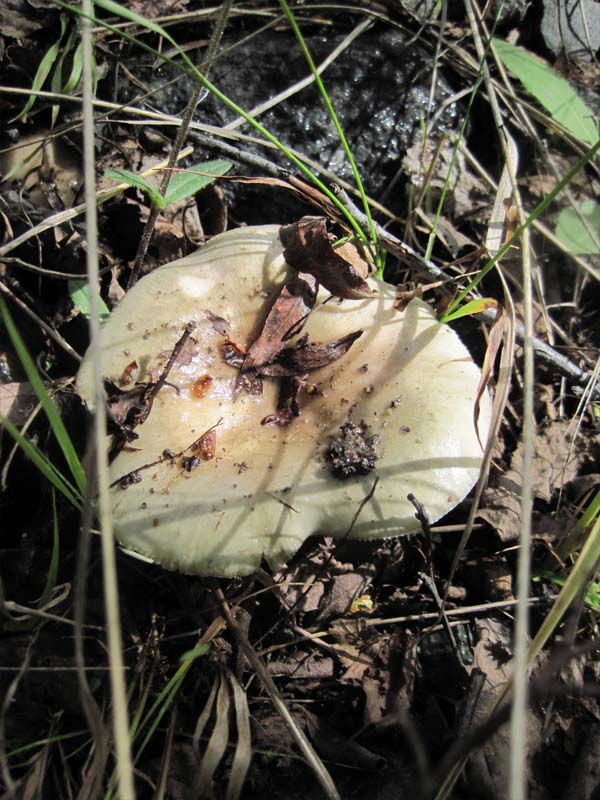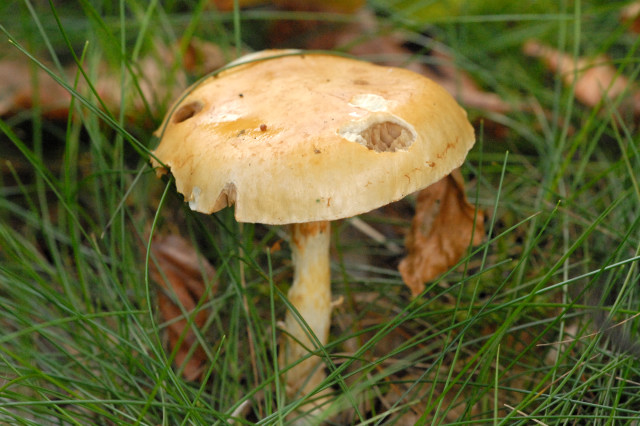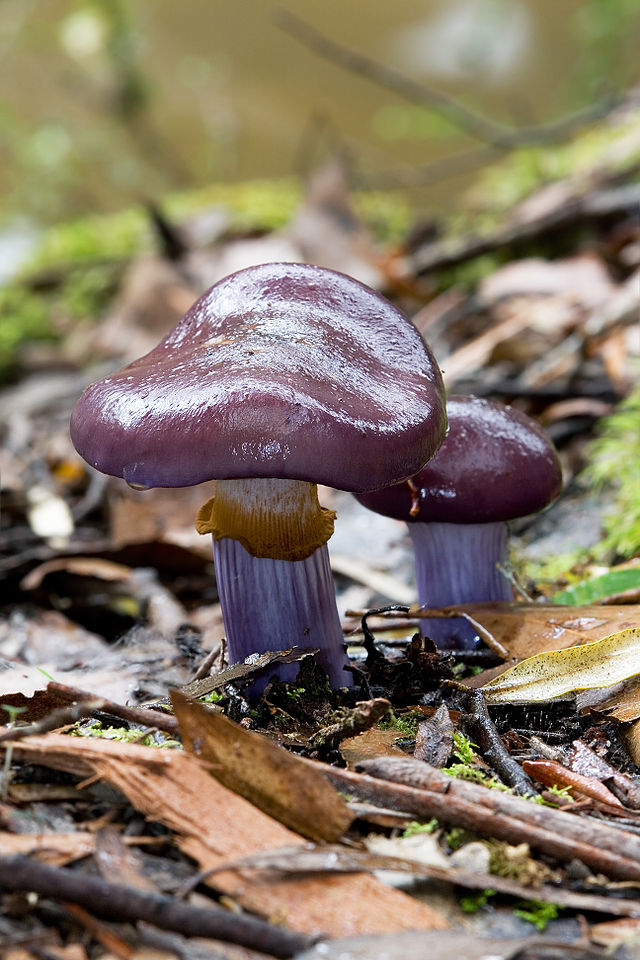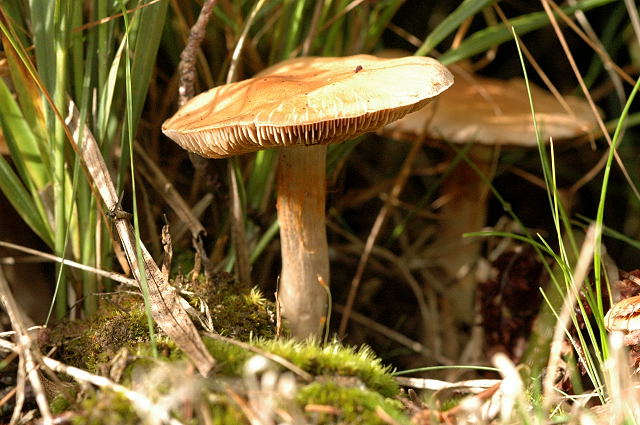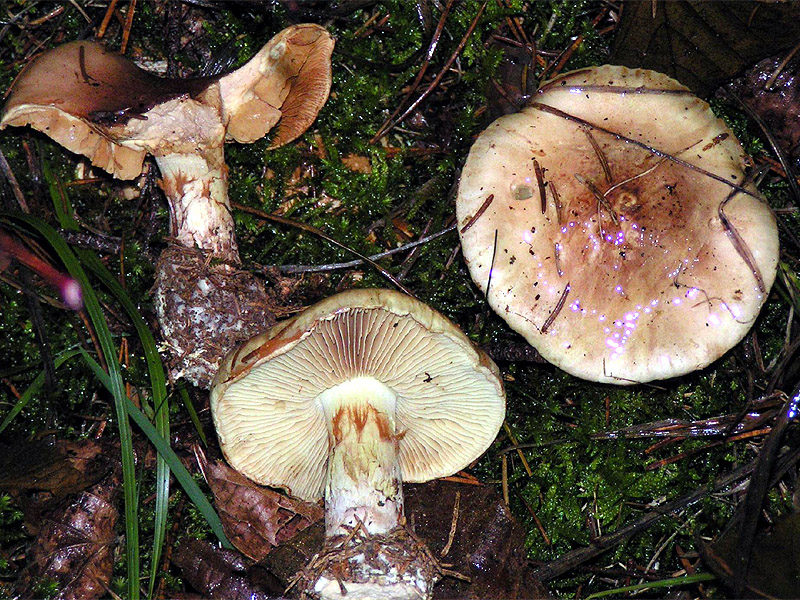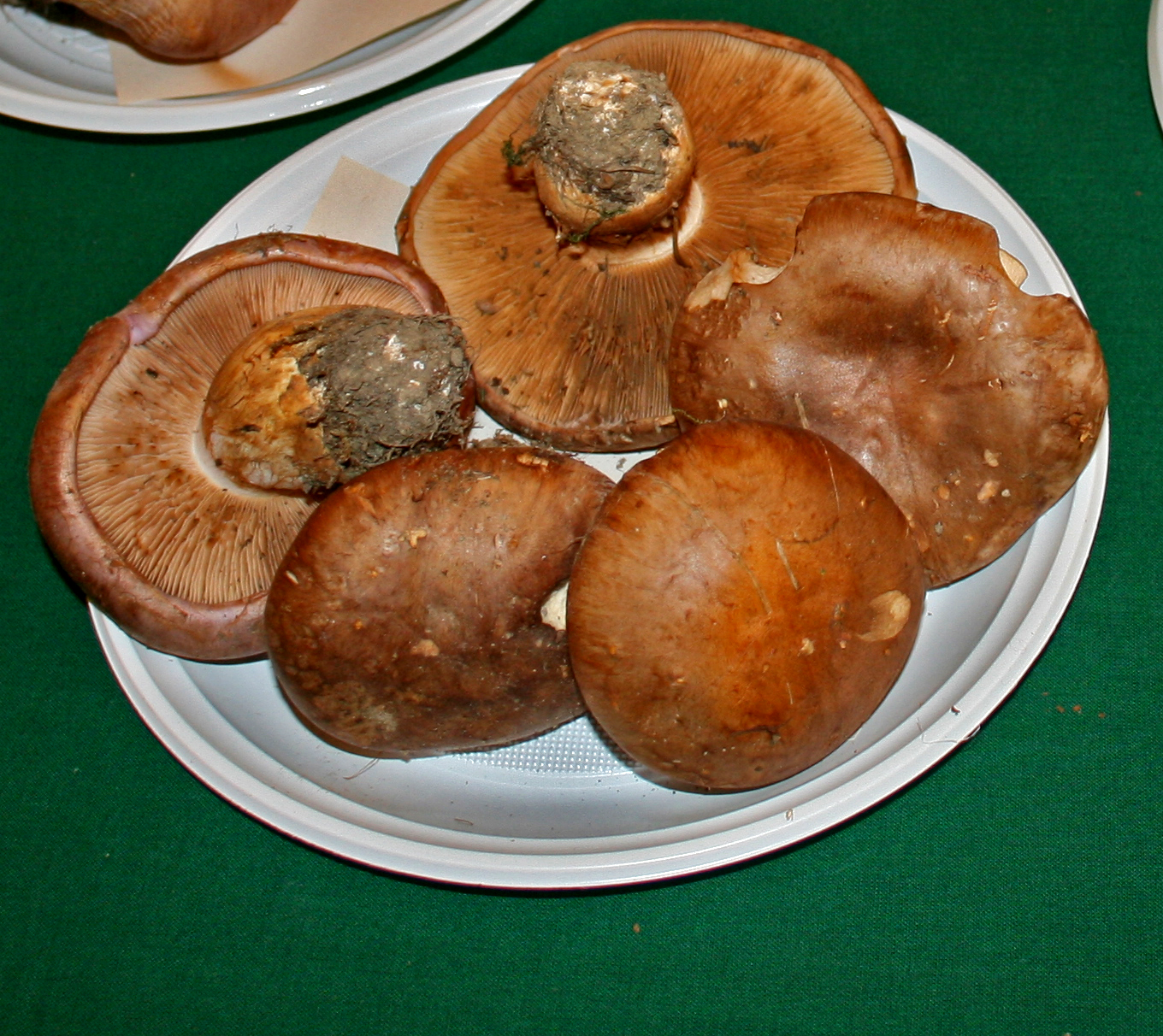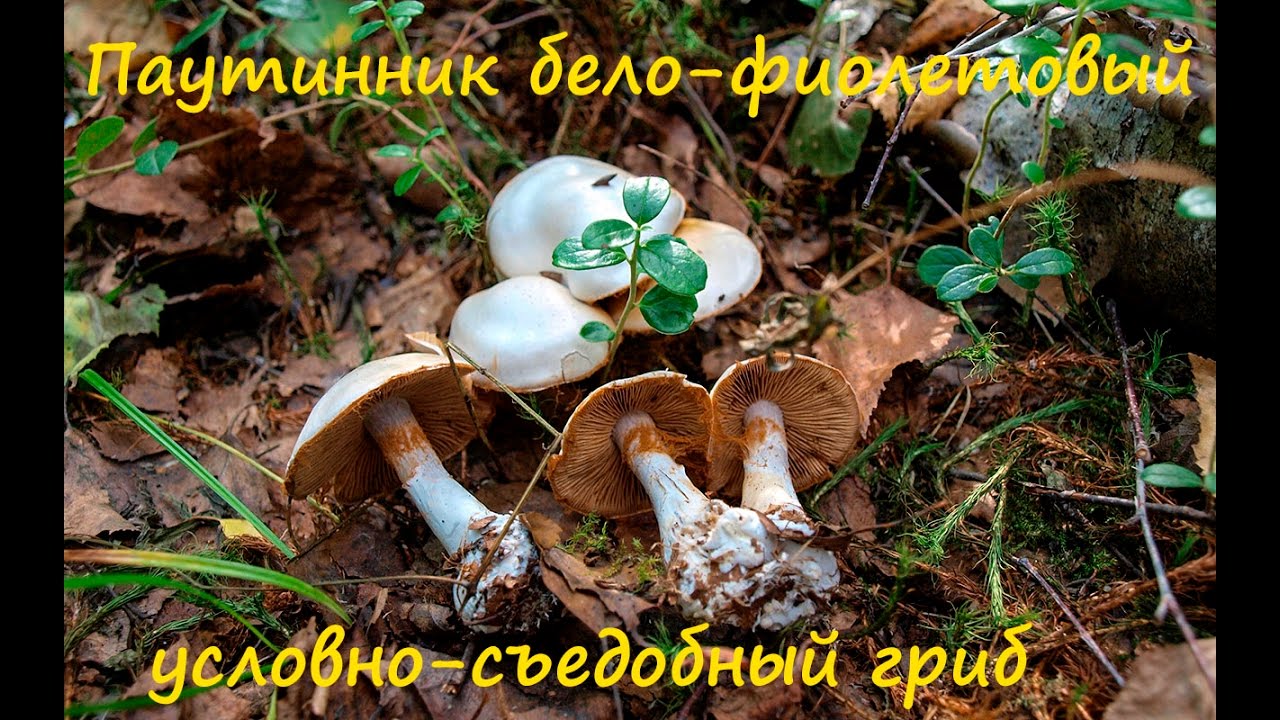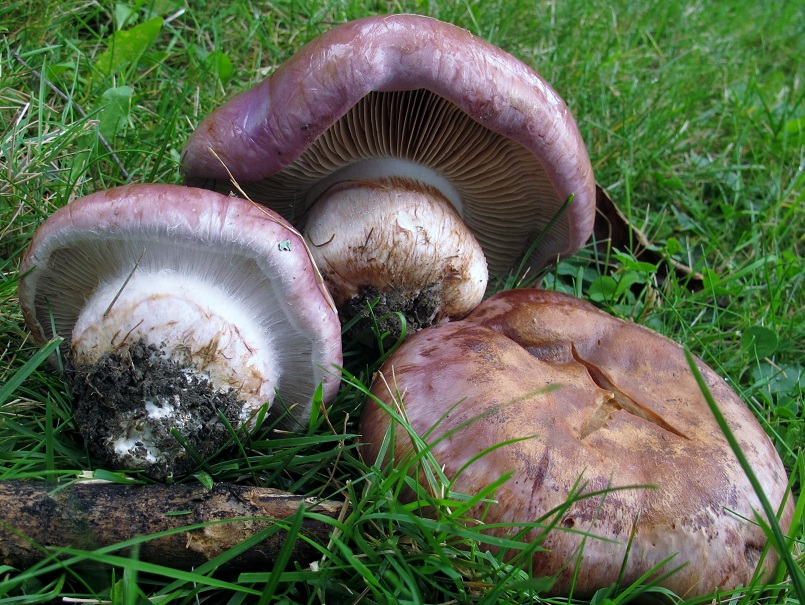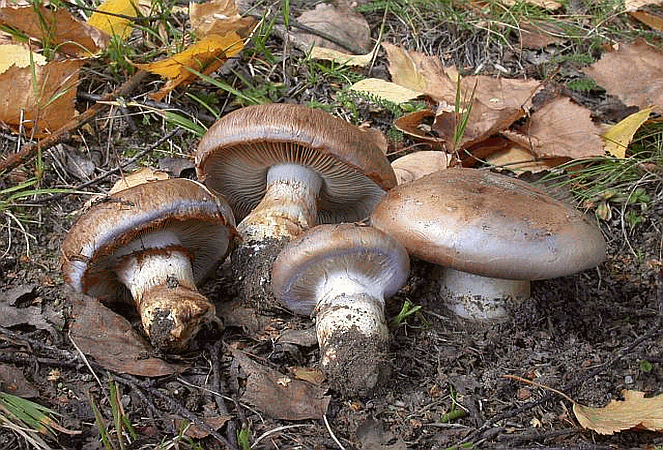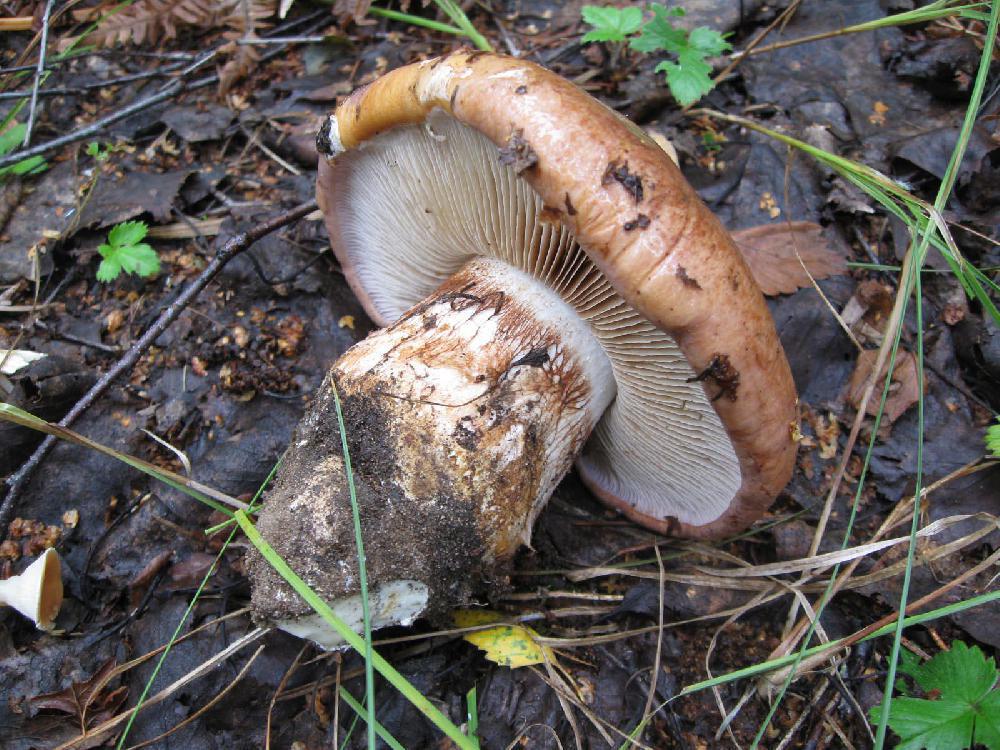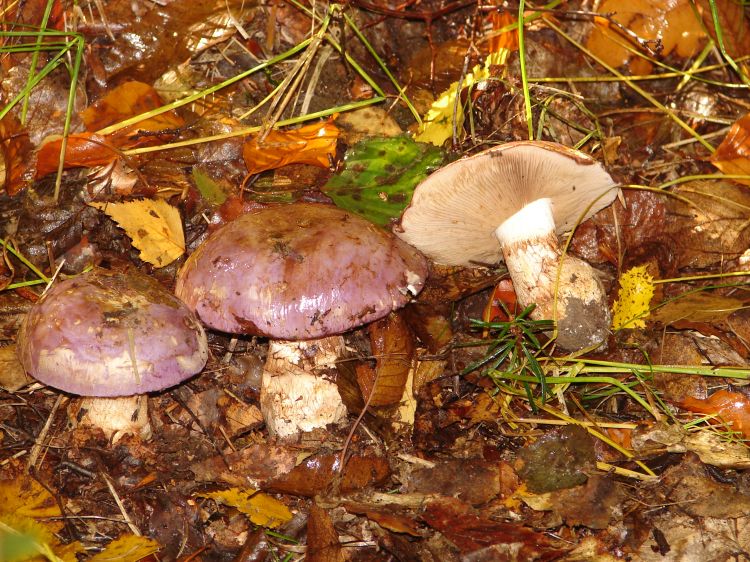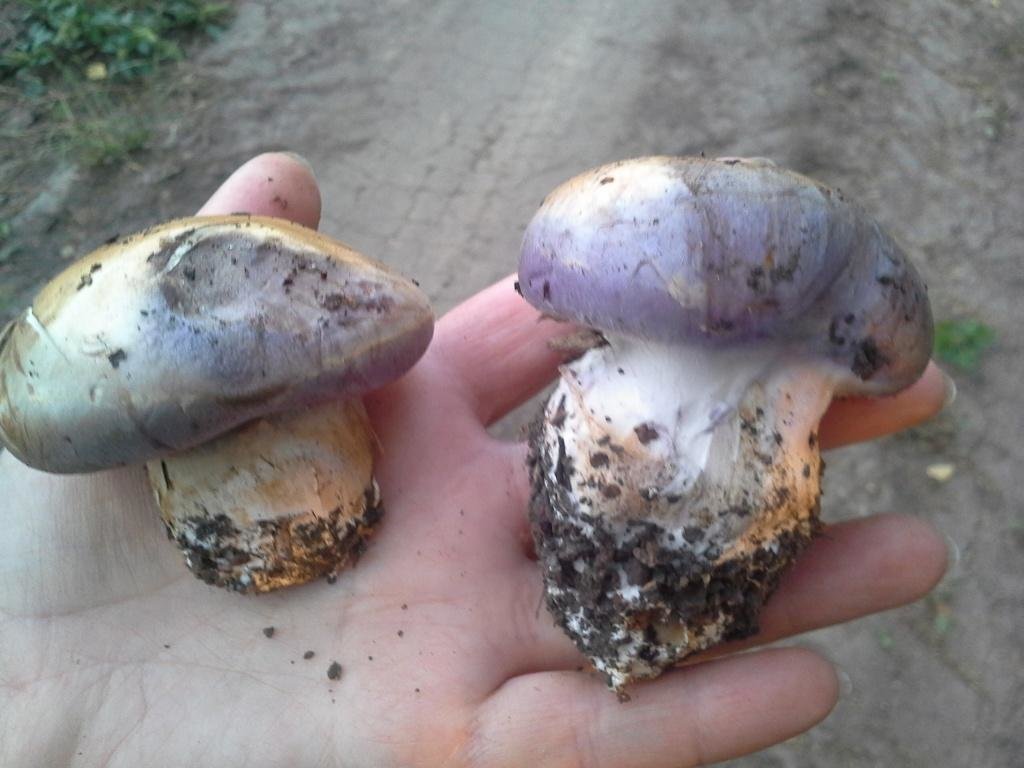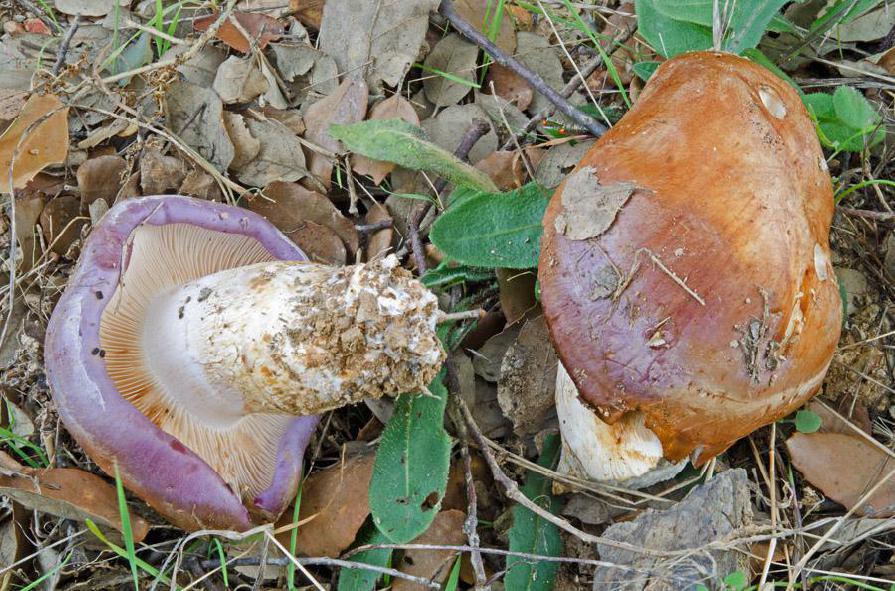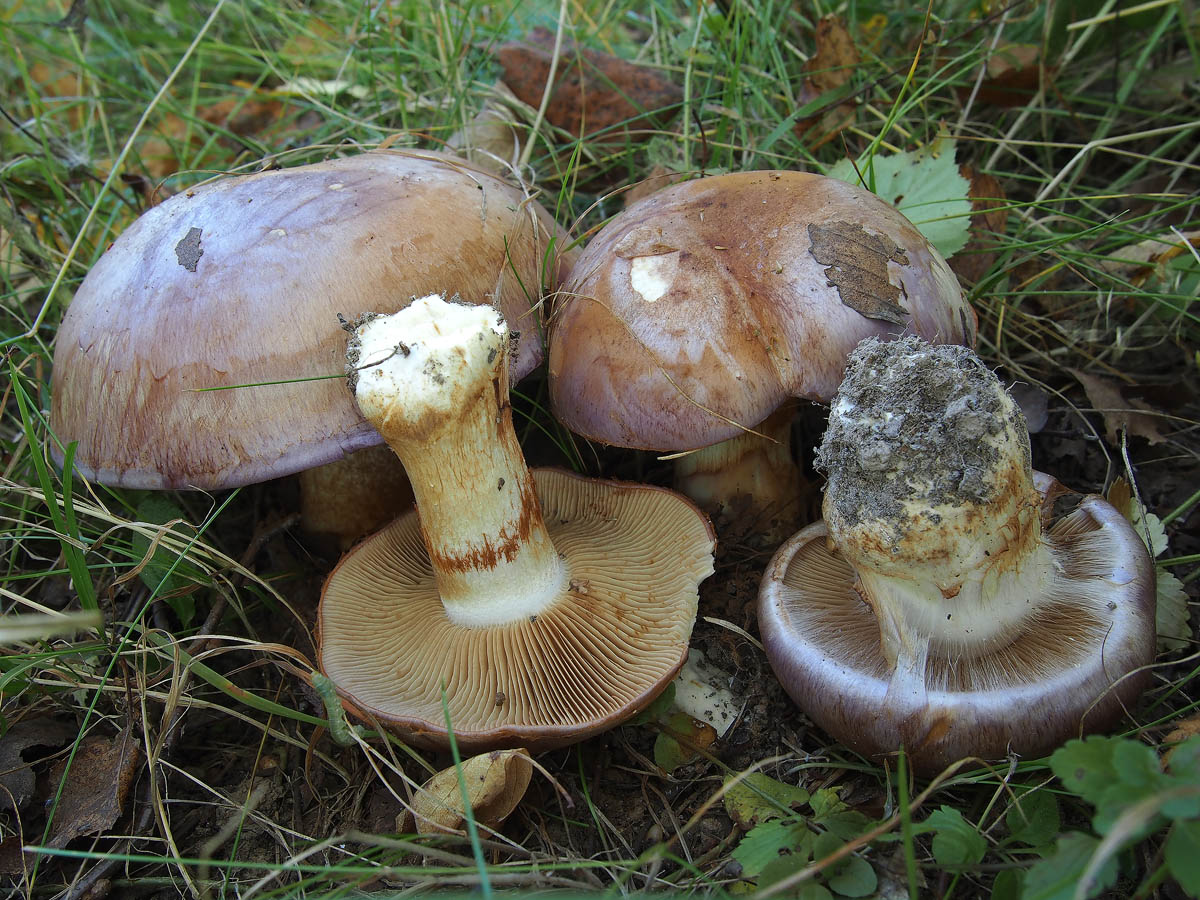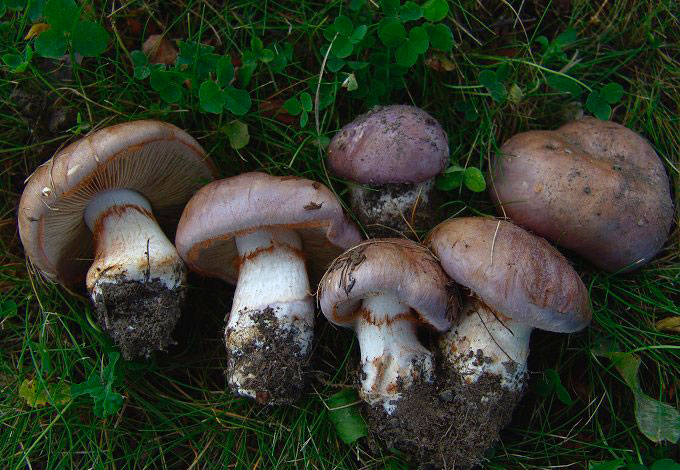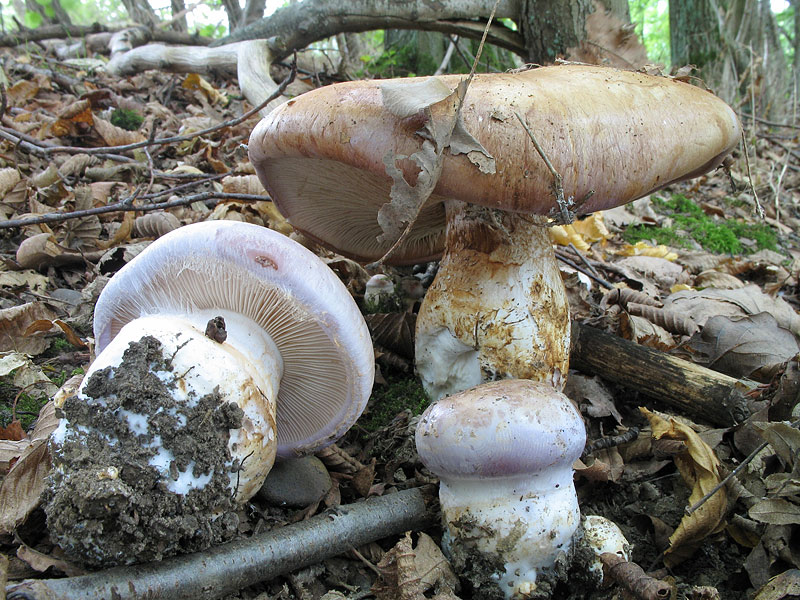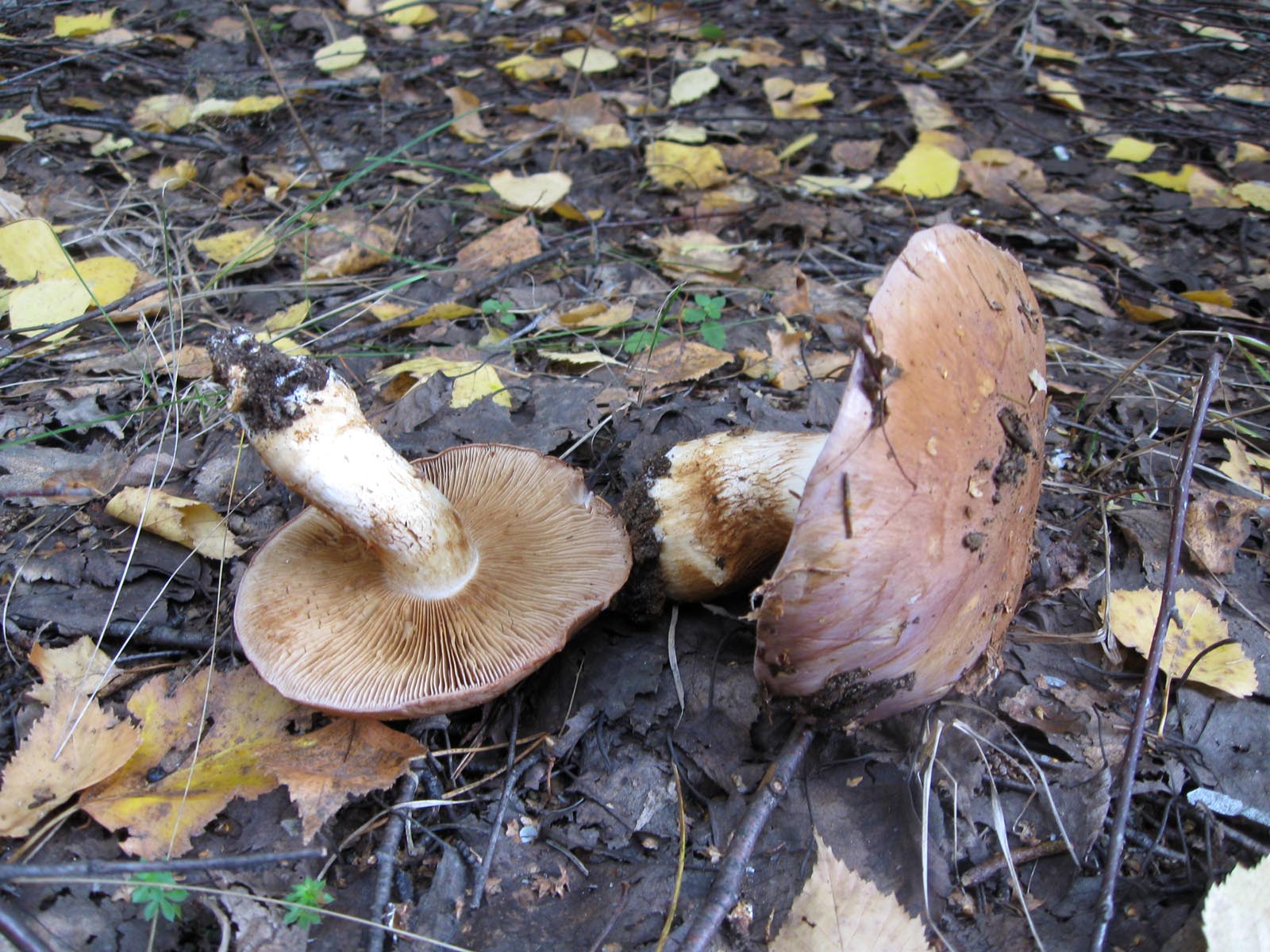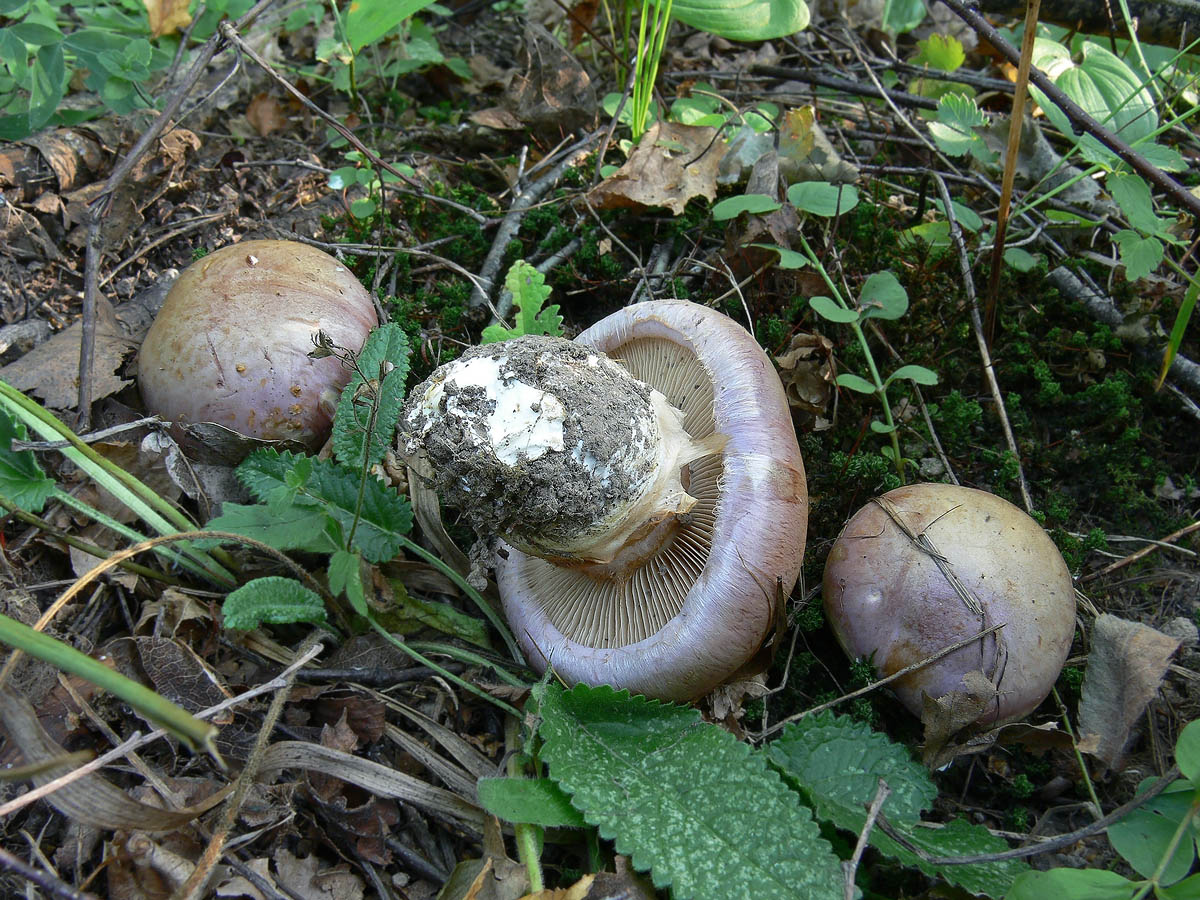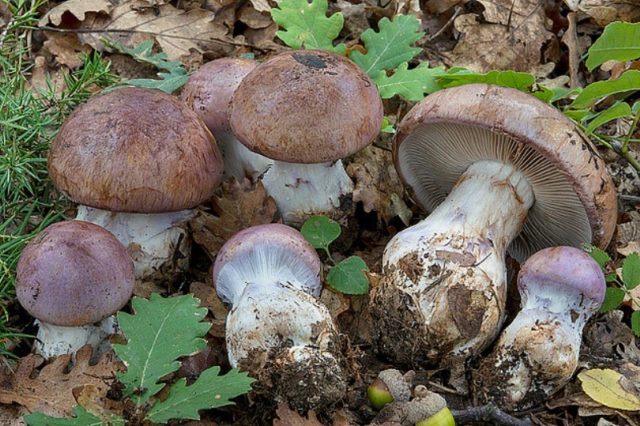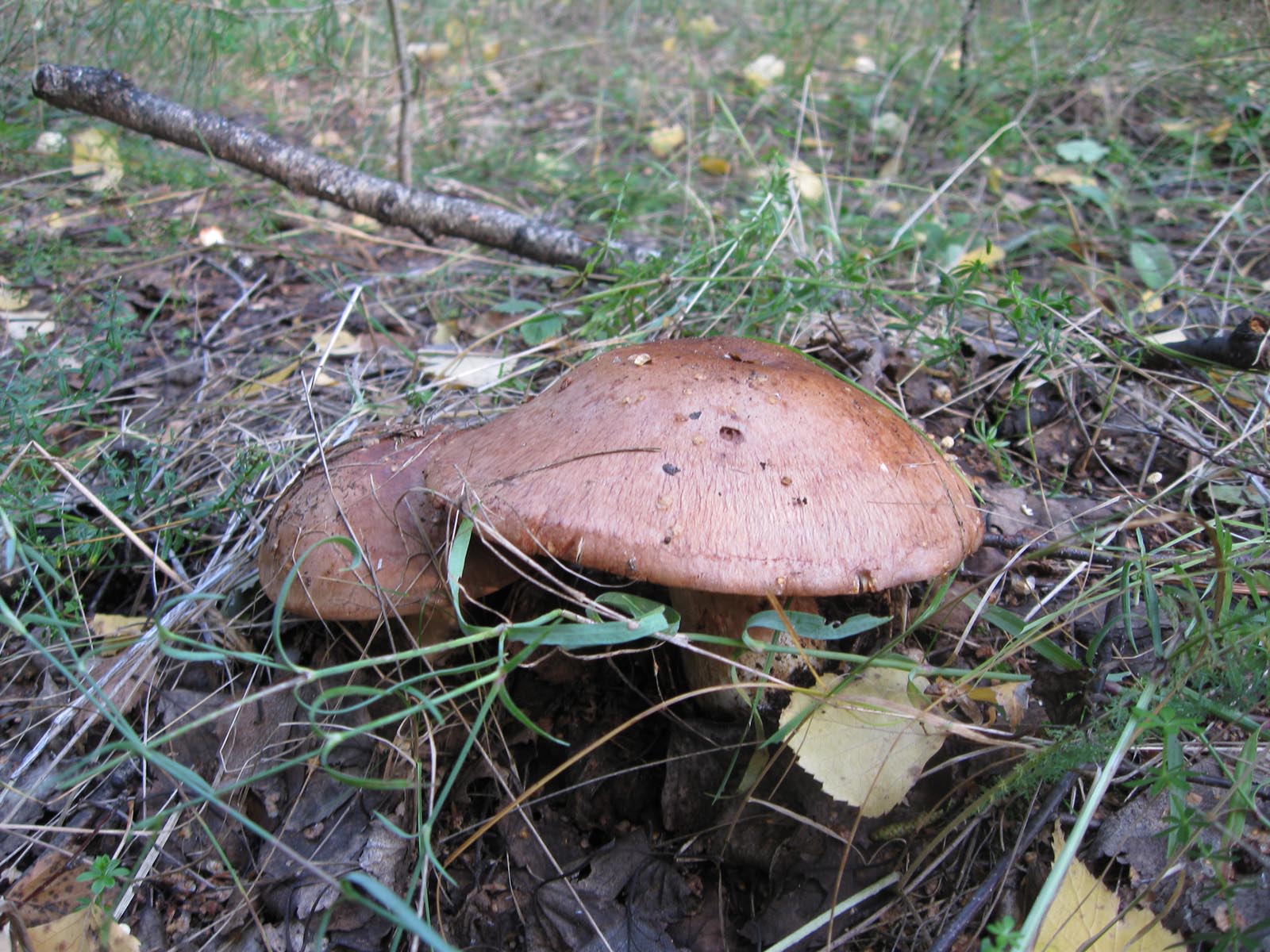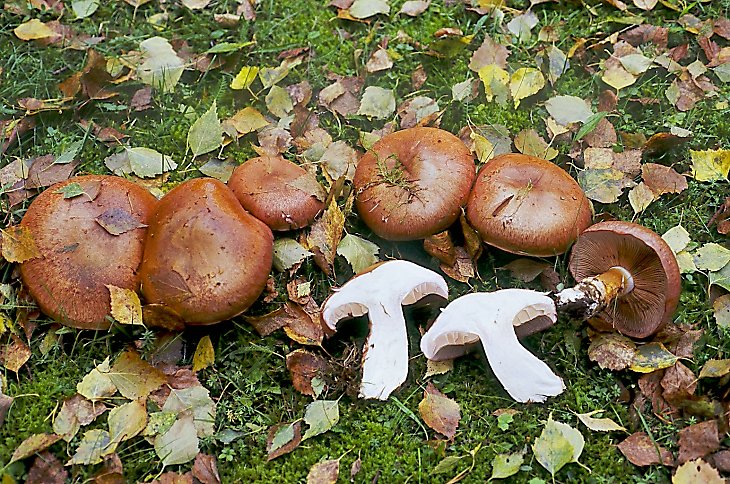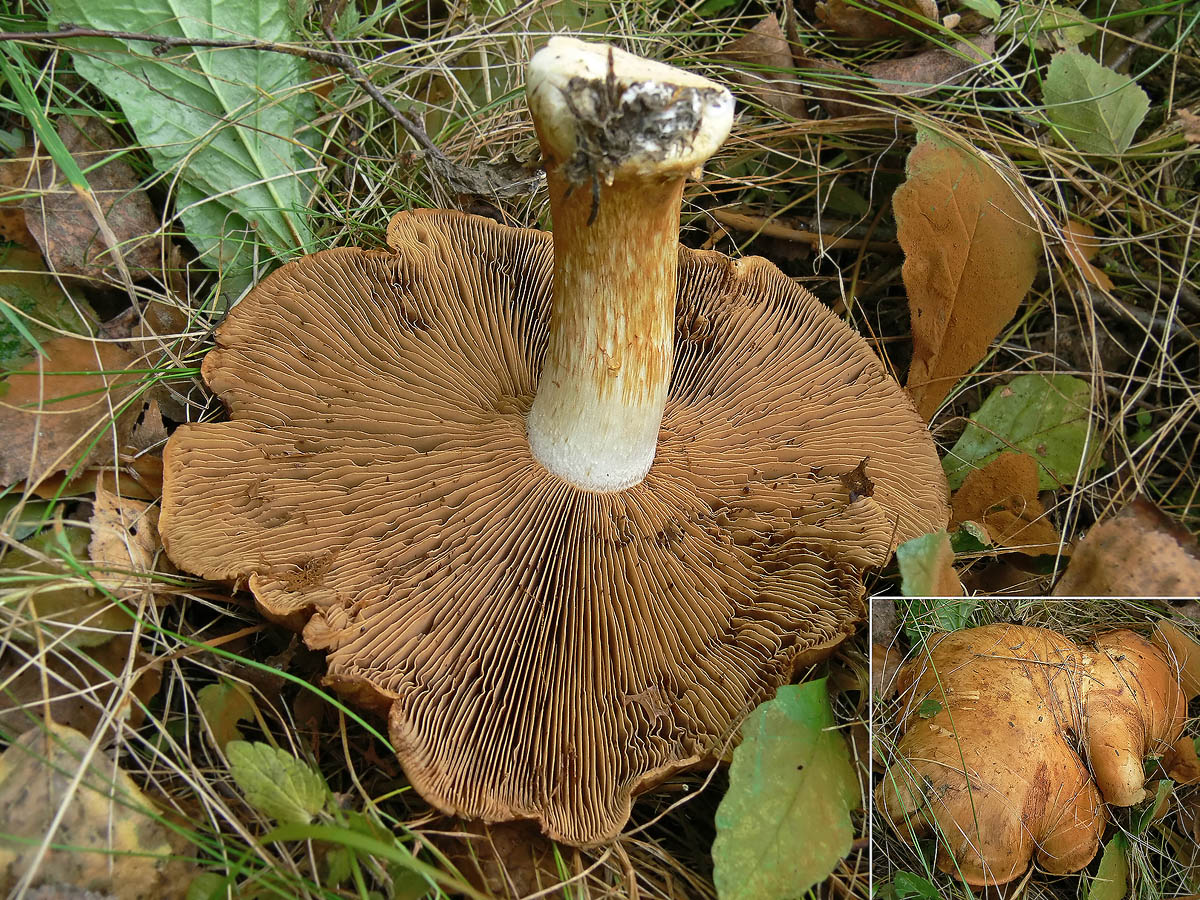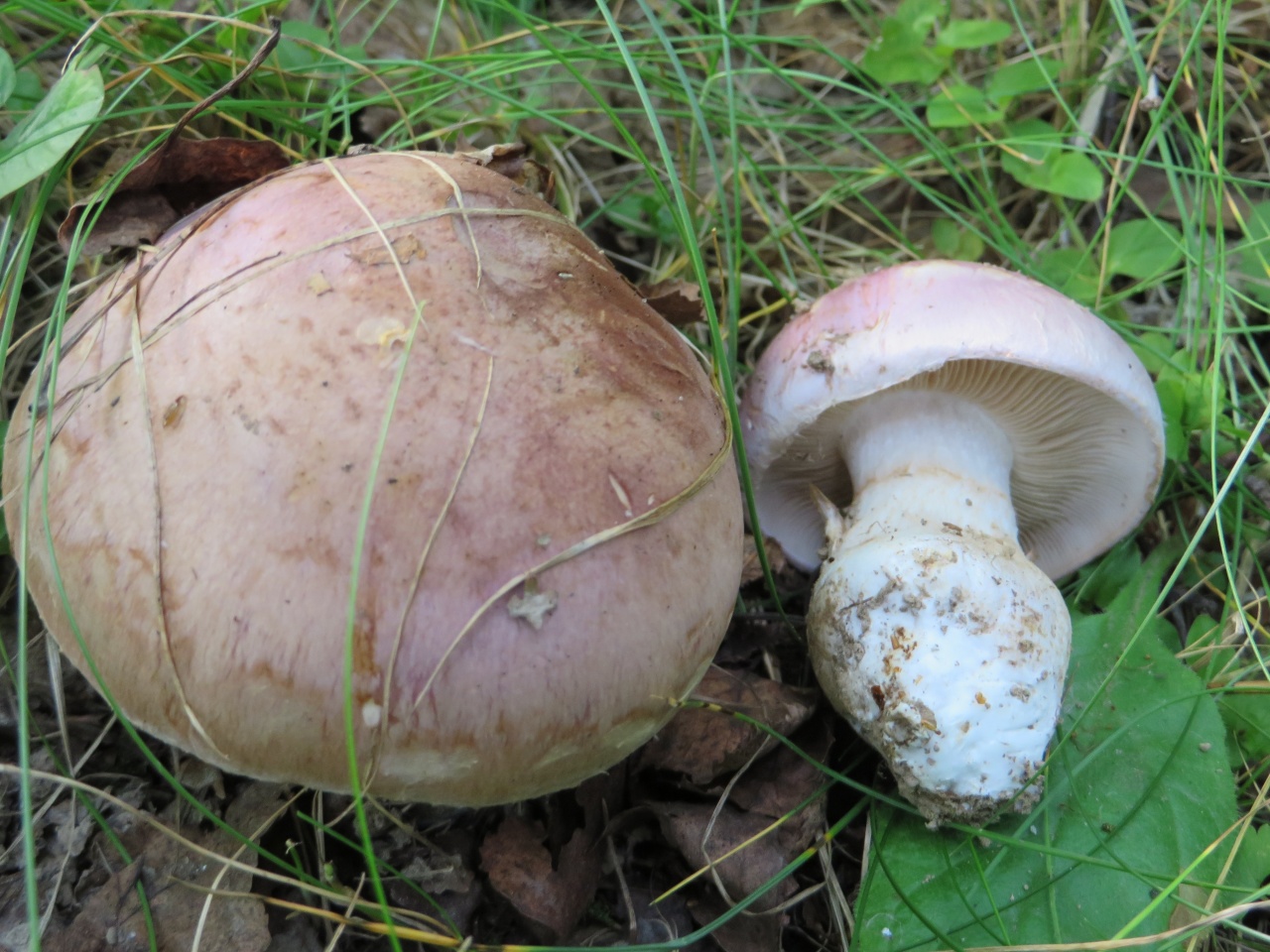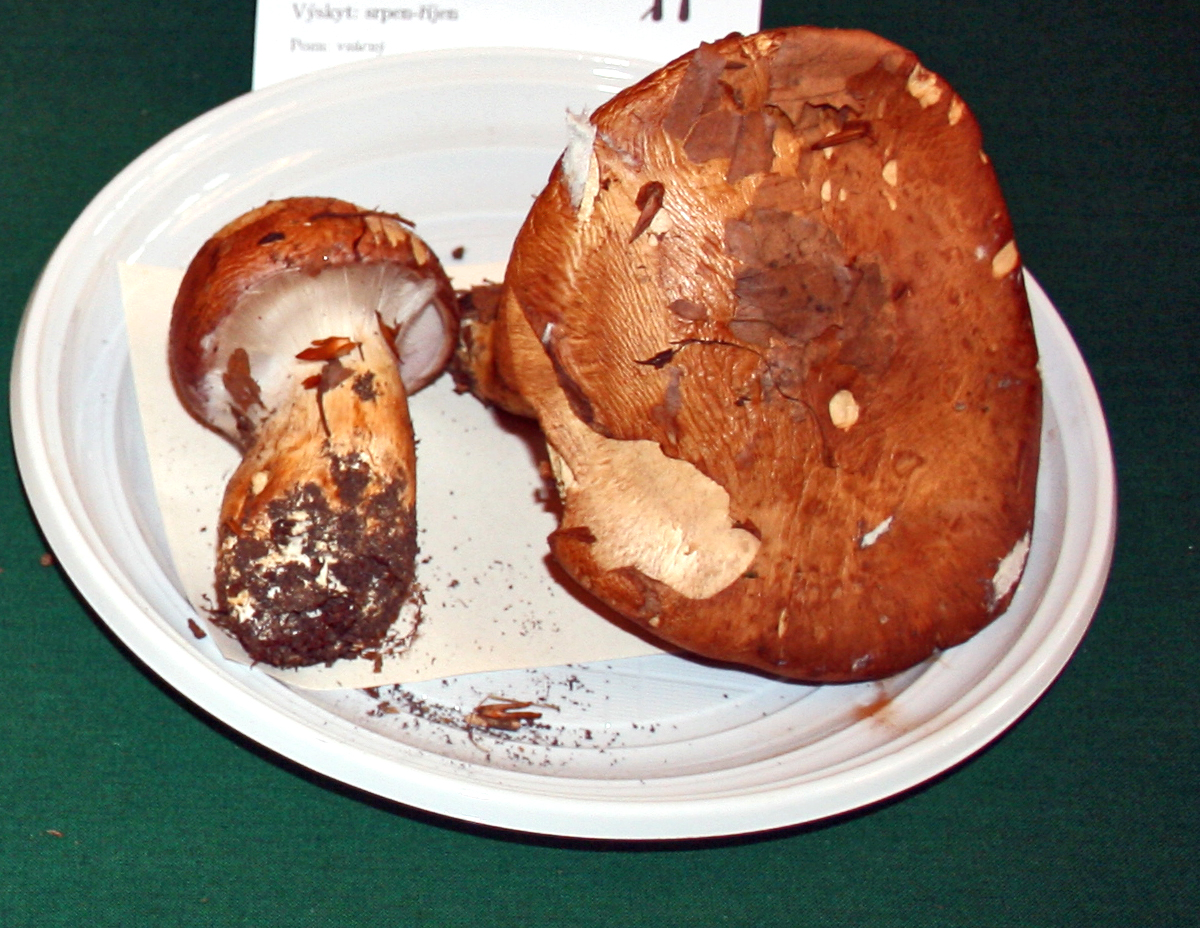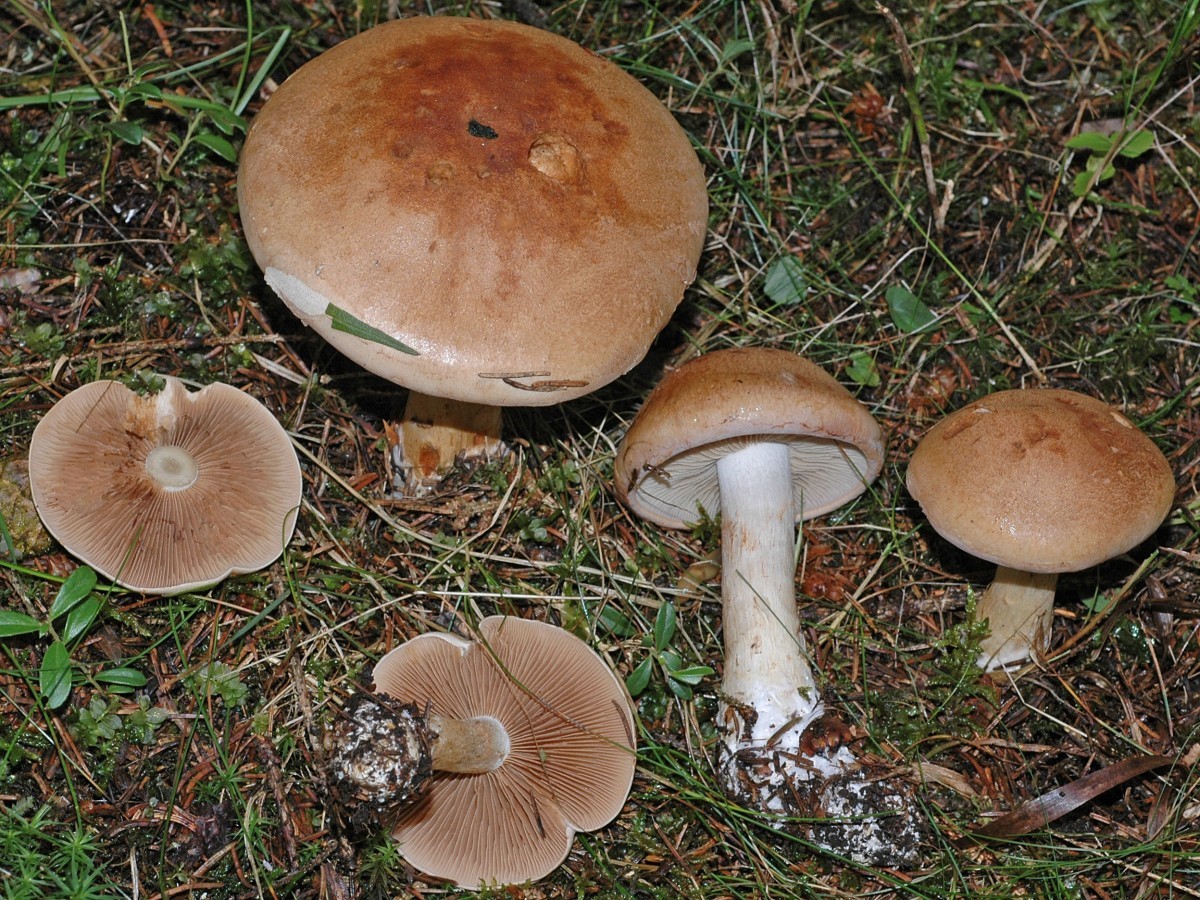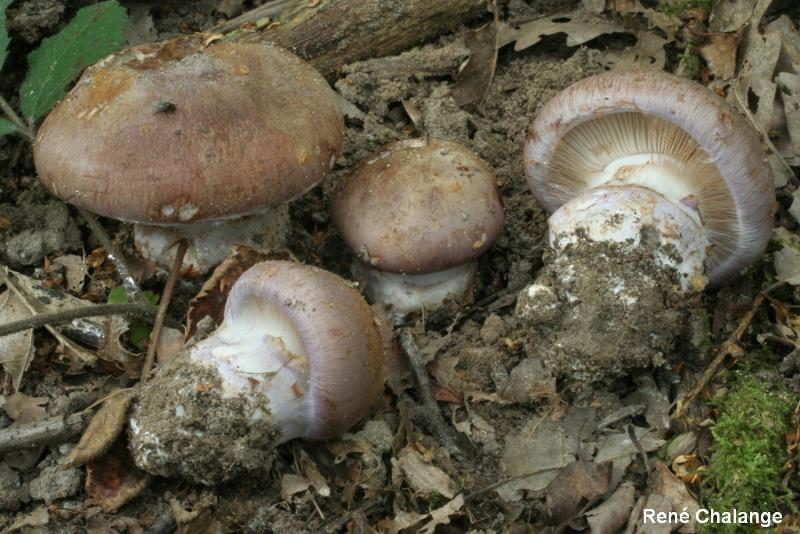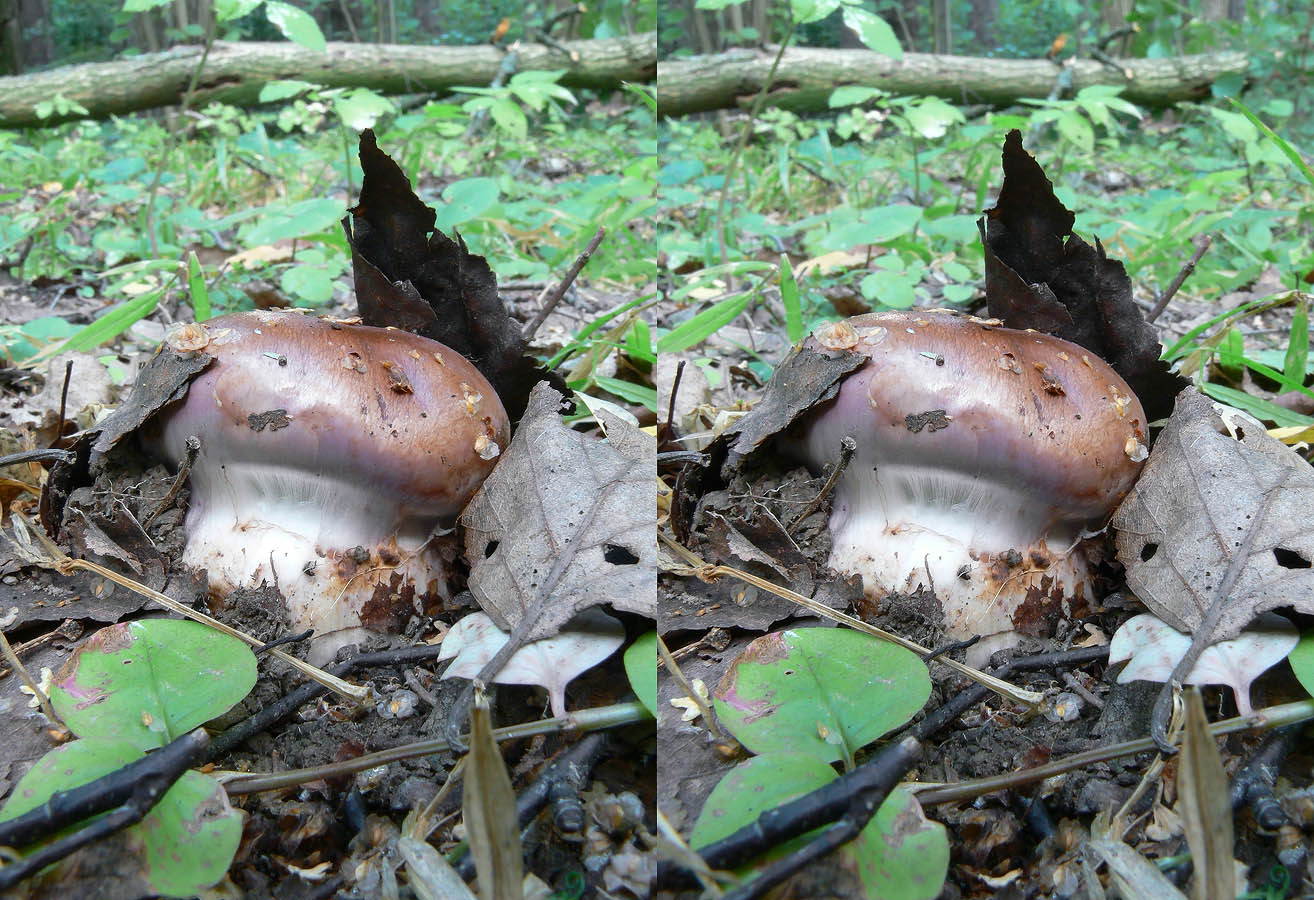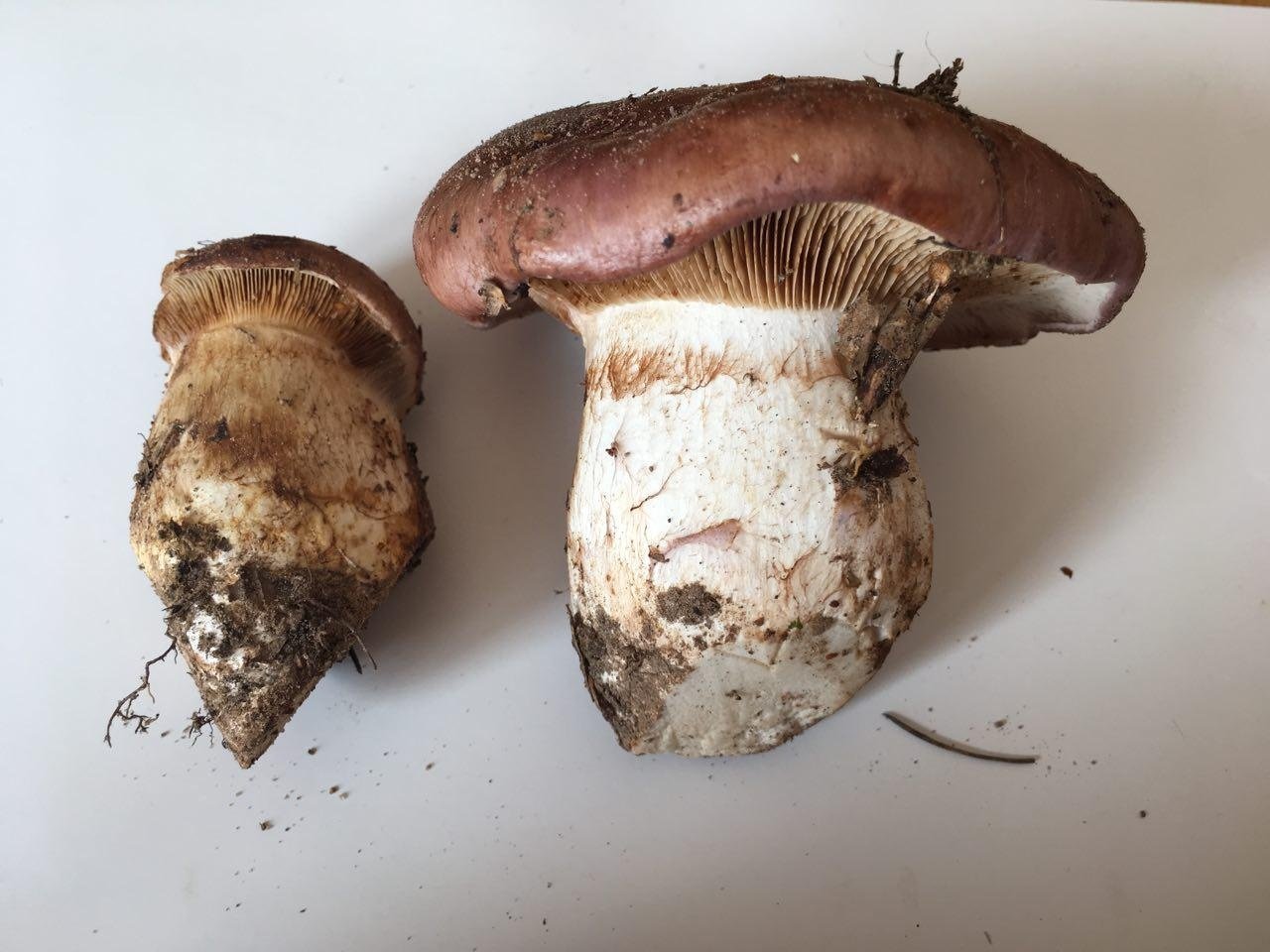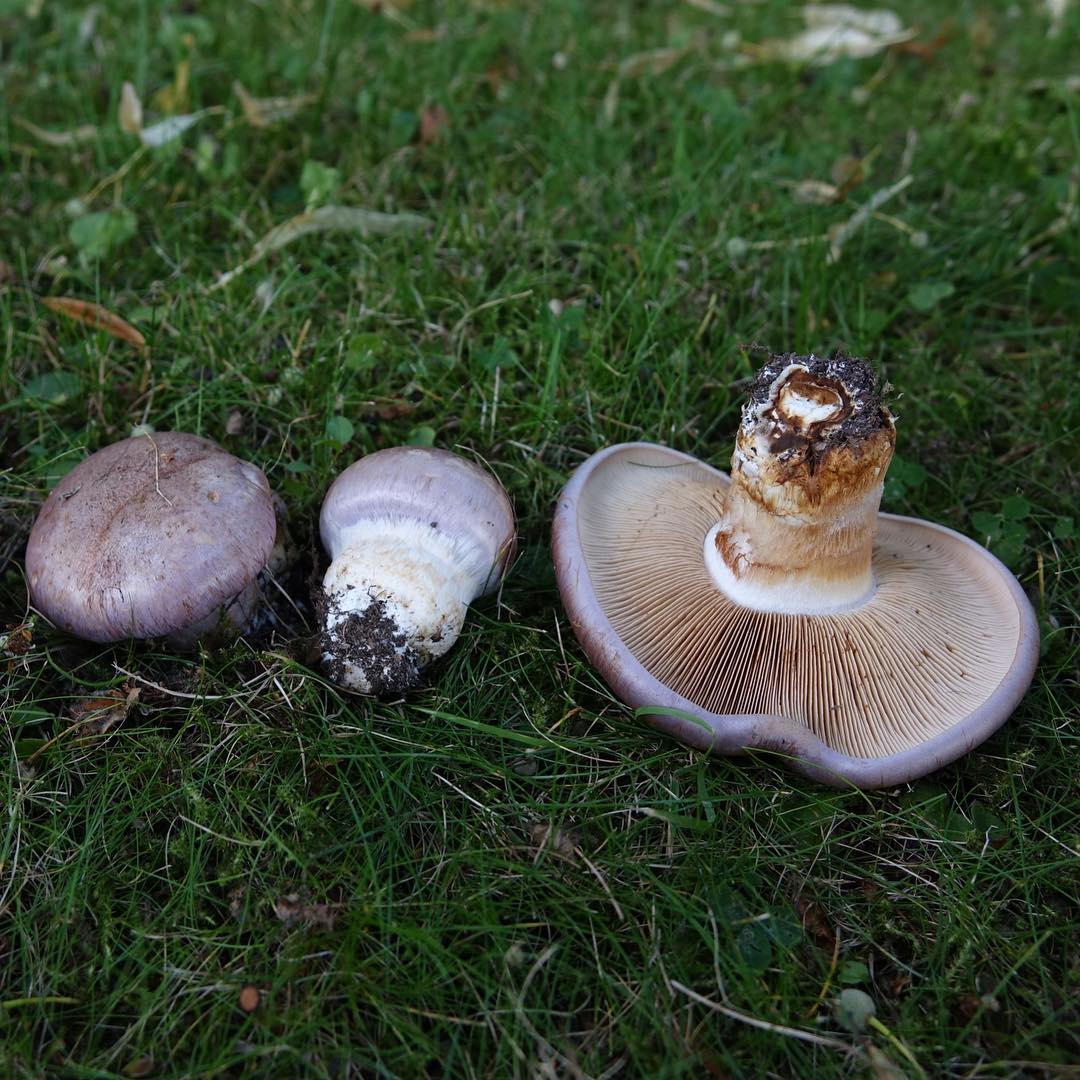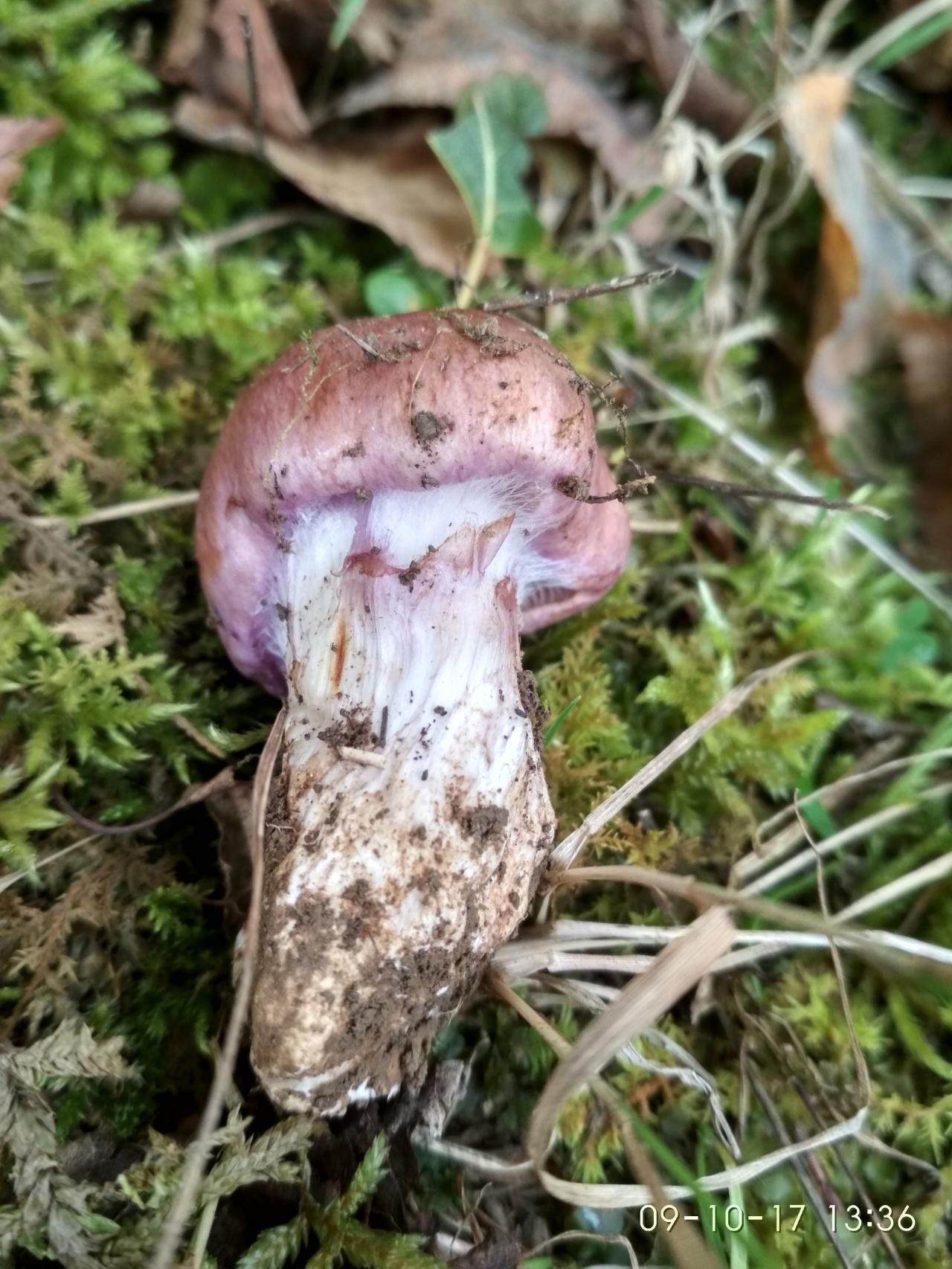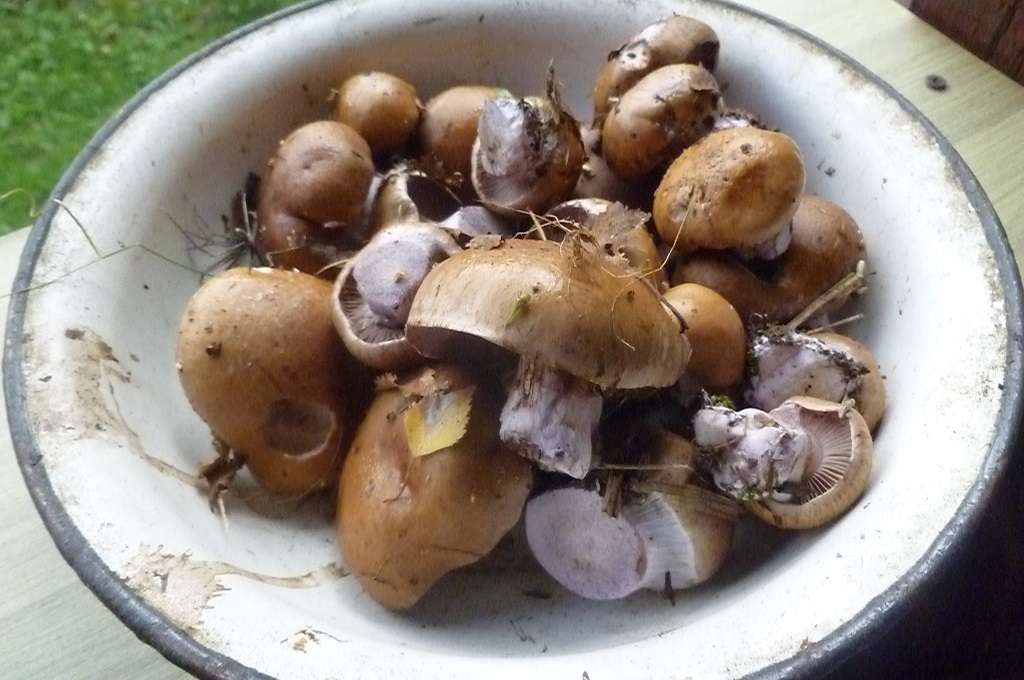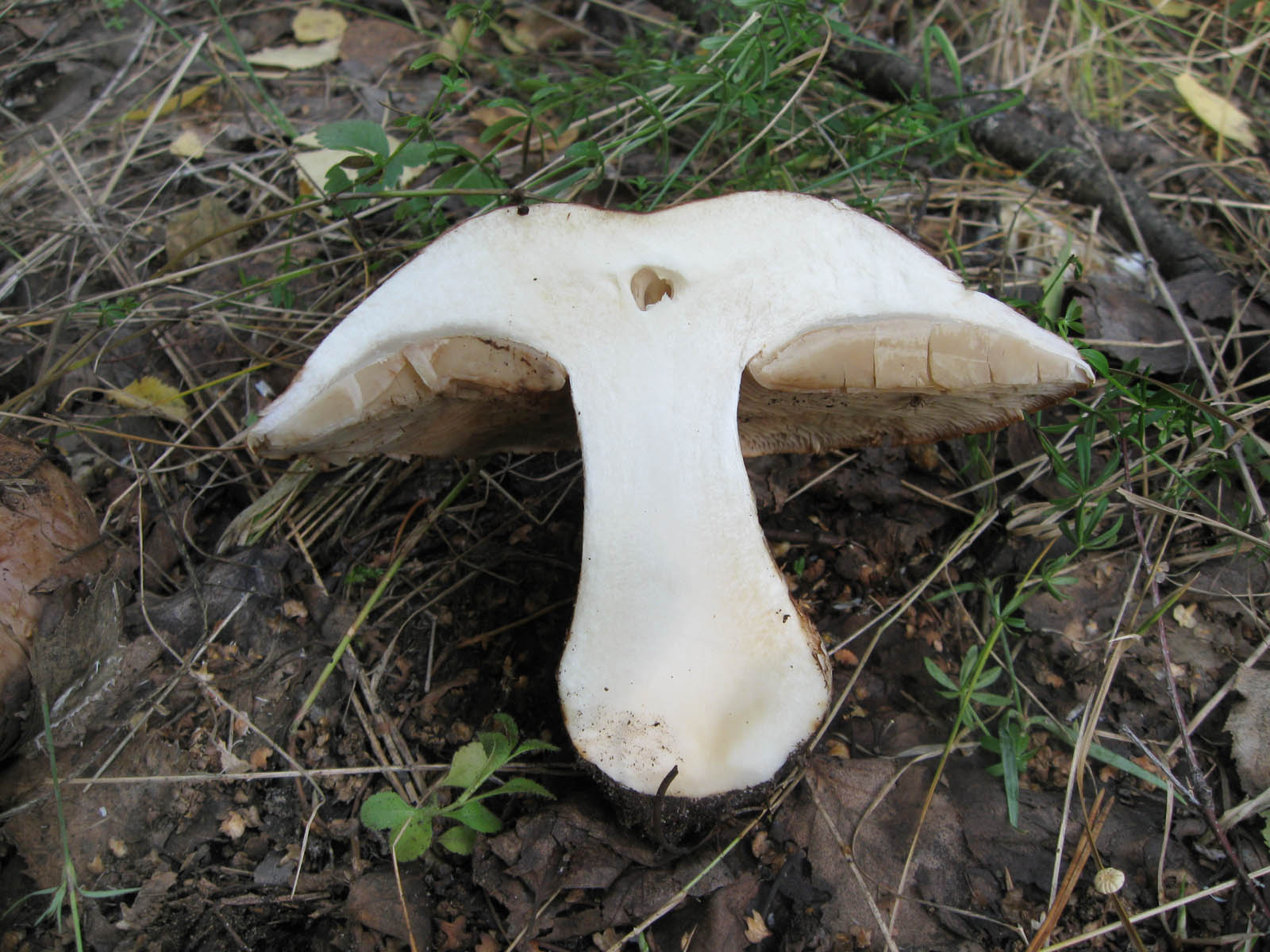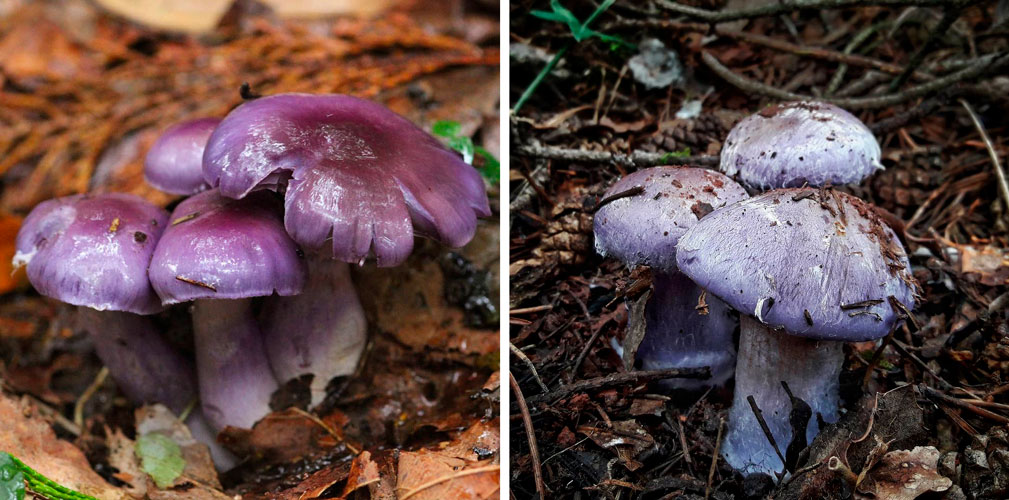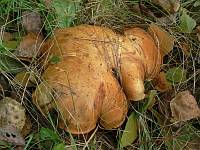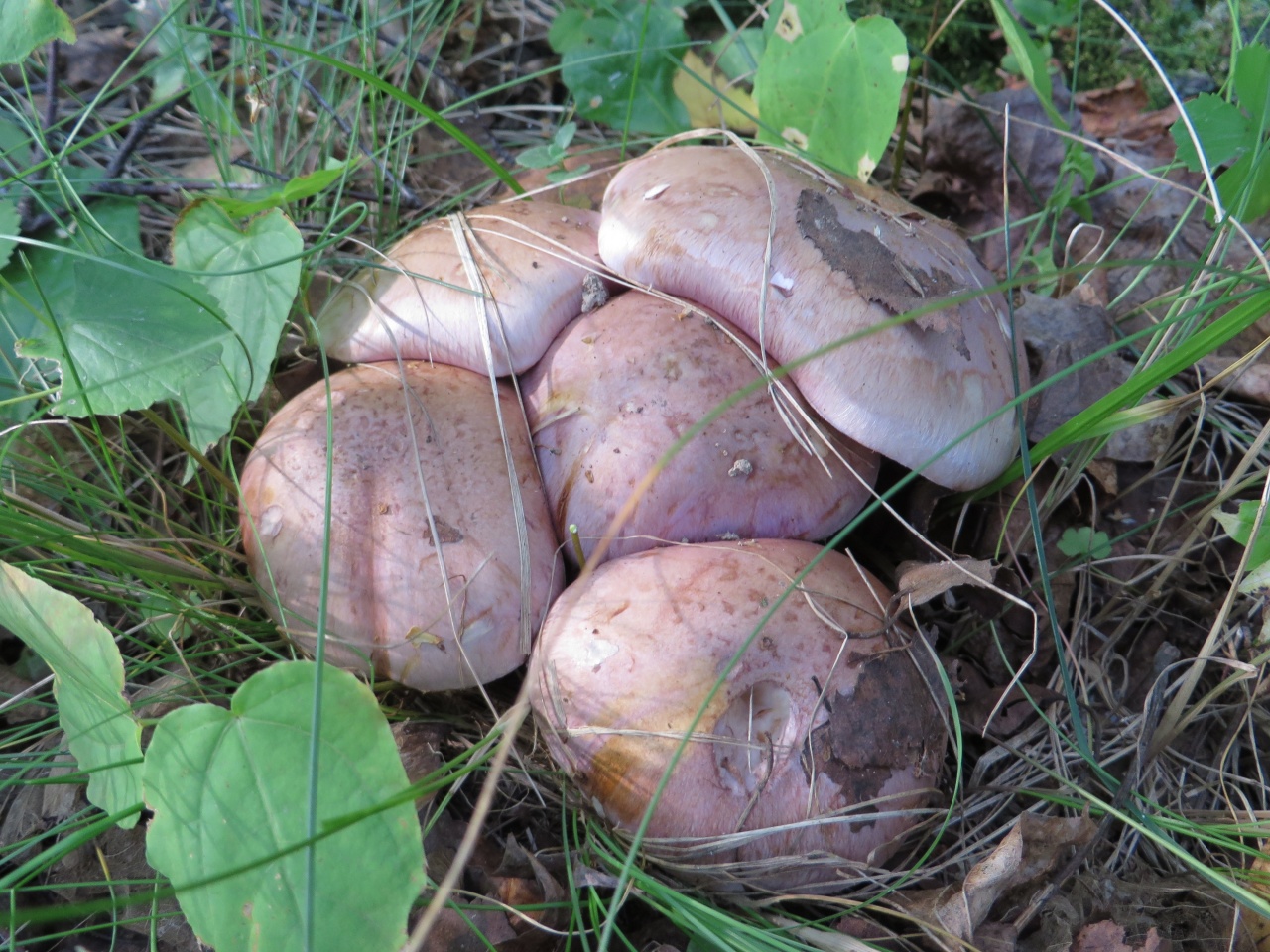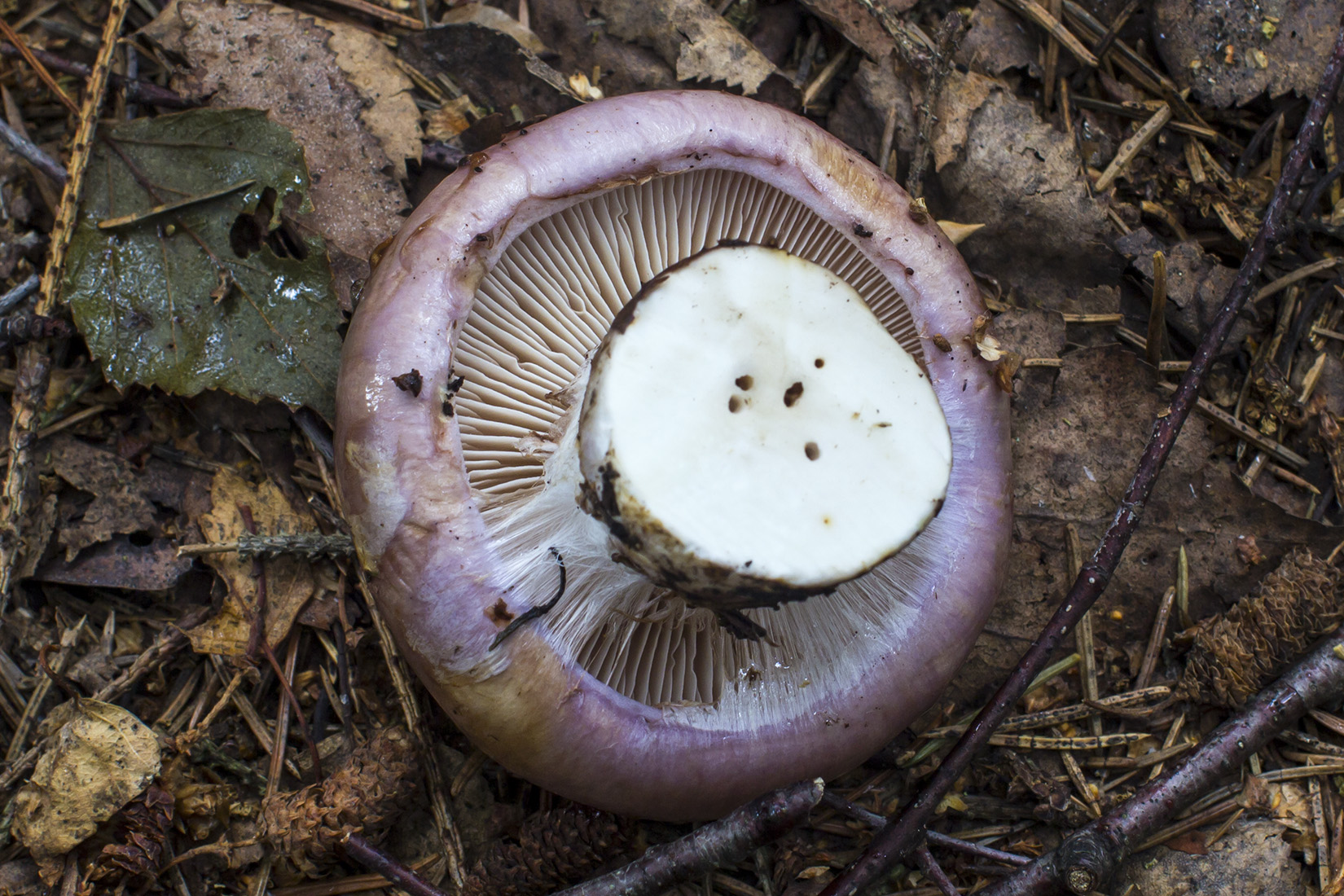Crimson webcap (Cortinarius purpurascens)
Scarlet webcap (Cortinarius purpurascens) - a mushroom, which according to some sources belongs to the edible, belongs to the Spiderweb genus, the Cobweb family. The main synonym for its name is the French term Cortinarius purpurascens.
External description
The fruit body of the crimson spider web consists of a leg 6 to 8 cm long and a cap, the diameter of which is up to 15 cm. Initially, the cap has a convex shape, but in ripening mushrooms it becomes prostrate, sticky to the touch and flat. The flesh of the cap is characterized by its fiber, and the color of the cap itself can vary from olive brown to reddish brown, with a slightly darker color in the central part. When the pulp dries, the cap ceases to shine.
The mushroom pulp is characterized by a bluish tint, but upon mechanical action and cutting it acquires a purple color. The pulp of this mushroom, as such, has no taste, but the aroma is pleasant.
The girth of the mushroom stalk varies within 1-1.2 cm, the stalk is very dense in structure, at the base it acquires a tuberous swollen shape. The main color of the stem of the mushroom is purple.
The hymenophore is located on the inner surface of the cap, and consists of plates adhered to the pedicle with a tooth, initially having a purple color, but gradually becoming rusty-brown or brownish. The plates contain a spore powder of rusty-brown color, consisting of almond-shaped spores covered with warts.
Season and habitat
Active fruiting of the crimson spider web occurs in the autumn period. The fungus of this species can be found in mixed, deciduous or coniferous forests, mainly at the end of August and throughout September.
Edibility
Information about whether the crimson cobweb is edible is controversial. Some sources say that this type of mushroom is allowed to be eaten, while others indicate that the fruiting bodies of this mushroom are not suitable for eating, since they have low taste. Conventionally, the crimson spider web can be called edible, mainly it is eaten salted or pickled. The nutritional properties of the species have been little studied.
Similar types and differences from them
The scarlet spider web is similar in appearance to some other types of spider web. The main distinguishing features of the species is the fact that the flesh of the described mushroom, under mechanical action (pressure), changes its color to bright purple.
White-purple spider web, Cortinarius alboviolaceus
Hat: Medium size (diameter 5-8 cm), fleshy, bell-shaped or hemispherical in youth, as the mushroom matures, it acquires a characteristic half-extended shape with a blunt tubercle in the center. Color - light gray or silvery with a purple tint; the surface is not slimy, smooth, silky, covered with rather rare radial fibers of a more violet color in comparison with the base. The pulp is thick, grayish, friable, with an unpleasant musty smell characteristic of many cobwebs.
Hymenophore: The plates are poorly adherent, of medium frequency, narrow, with frequent veins; in adult mushrooms, they are rusty-brown; in young ones, while covered with a light gray cortina, they are gray-gray, bluish, but already with rusty edges.
Spore powder: Rusty brown.
Leg: Long and powerful (height 6-10 cm, thickness 1.5-2 cm), cylindrical, evenly expanding to the bottom, cap color, often with blue stains. The remnants of the silvery cortina are usually not visible, but when ripening spores fall on it, it becomes rusty-brown in color and becomes very noticeable. The flesh of the leg is gray-bluish, unevenly colored, often watery and friable.
Spreading: The white-purple webcap is found in September-October in deciduous and mixed forests, forming a mycorrhiza with a variety of trees. Prefers moist places, mosses, where it can appear in large quantities.
Similar species: There are many similar mushrooms among the endless genus of spider webs. From more violet varieties such as Cortinarius traganus, the white and purple cobweb is easily distinguished by the color of the cap, which is never so blue; Unlike C. salor, our figurant's leg and cap are not particularly slimy, except maybe rain. How to distinguish Cortinarus alboviolaceus from the silvery spider web, Cortinarius argentatus, does not exist in the popular literature; obviously, one should rely on the presence or absence of blue tones in the color. In general, the distinction of cobwebs, even such noticeable as white and purple, is extremely unpromising.
Edibility: According to literature data, it is not poisonous; according to the same data, it does not bring gastronomic joy to anyone.
Author's notes: The reportable Cortinarius alboviolaceus is another cobweb that can be identified right in the forest with at least some nonzero probability. That's why we love him. If it is, of course, he.
The tubercle is not visible, but it is. The white-purple cobweb is somewhat smaller than most similar blue or purple cobwebs, but in texture this mushroom is not much different from them - the same powerful and lumpy-headed. Under the silvery layer on the cap and stem, the latent blue is clearly visible, which gives a good reason to record this specimen in Cortinarius alboviolaceus.
The plates are brown, and the stripes on the leg are rusty. The rusty stripes on the leg of this white and purple spider web are the remains of a cortina, strewn with spores of the corresponding color. Why are cobwebs good - you don't even need to make an eruption of spore powder, everything is in full view. However, this feature does not help in the definition. Such are the mushrooms - cobwebs. Woven, excuse the expression, of riddles and contradictions.
Common webcap (Cortinarius trivialis) what it looks like, where and how it grows, edible or not
Common webcap: photo and description
| Name: | Common webcap |
| Latin name: | Cortinarius trivialis |
| Type of: | Inedible |
| Specifications: |
|
| Systematics: |
|
The common webcap (lat.Cortinarius trivialis) is a small mushroom of the Cobweb family. The second name - Pribolotnik - he received for preference to growing conditions. It is found in wet, swampy areas.
A detailed description of the Common Webcap with photos and videos is presented below.
Description of the common webcap
The mushroom was called a cobweb for a kind of "veil" of a cobweb film that is present in young specimens. The rest of the appearance is unremarkable.
Description of the hat
Pribolotnik's cap is small: 3-8 cm in diameter. At the initial stage of development, it has the shape of a hemisphere, which is later revealed. The color of the cap ranges from pale yellow tones to ocher and light brown shades. The core is darker than the edges.
The cap is sticky to the touch, there is a small amount of mucus on it. The surface of the hymenophore is lamellar. In young fruit bodies, it is white, and in mature specimens it darkens to yellowish and brown tones.
The pulp is dense and fleshy, white, with a harsh odor.
Leg description
The leg is 6-10 cm in height, the diameter is 1.5-2 cm. Slightly narrowed towards the base. There are specimens with a reverse structure - there is a small expansion at the bottom. The color of the leg is white, closer to the ground it darkens to a brown tint. Above from the cobweb blanket are brown concentric fibrous bands. From the middle of the leg to the base - weakly expressed.
Where and how it grows
Podbolnik can be found under birches and aspens, rarely under alder. It rarely lives in coniferous forests. Grows singly or in small groups in damp places.
In Russia, the distribution area of the species falls on the middle climatic zone.
Fruiting from July to September.
Edible webcap common or not
The nutritional properties of the Common Webcap have not been studied, but it does not apply to edible mushrooms. This species cannot be eaten.
Related specimens contain dangerous toxins in the pulp.
Poisoning symptoms, first aid
The danger of toxic species of this family is that the first signs of poisoning appear gradually: up to 1-2 weeks after eating mushrooms. Symptoms look like this:
- intense thirst;
- nausea, vomiting;
- stomach ache;
- spasms in the lumbar region.
If you find the first signs of poisoning, you must urgently consult a doctor or call an ambulance. Before receiving qualified treatment, you need to:
- flush the stomach using activated charcoal;
- plentiful drink (3-5 tbsp. boiled water in small sips);
- take a laxative to cleanse the intestines.
Doubles and their differences
The podbolnik is confused with other members of the family, as they are quite similar. The greatest similarity is noted with the mucous webcap (lat.Cortinarius mucosus).
The hat is 5-10 cm in diameter. It has a thin edge and a thick center, abundantly covered with transparent mucus. The leg is slender, cylindrical, 6-12 cm long, 1-2 cm thick.
It differs from Pribolotnik in abundant mucus and the shape of a cap.
Grows in coniferous and mixed forests under pine trees. Bears fruit singly.
The slime webcap (lat.Cortinarius mucifluus) is another twin of the Pribolotnik, which is confused with the mucous webcap because of a similar name. The hat with a diameter of 10-12 cm is abundantly covered with mucus. The stem is 20 cm long in the form of a spindle, also covered with mucus. Prefers coniferous forests.
It differs from Pribolotnik in abundant mucus and a longer leg.
Conclusion
The common webcap is an inedible mushroom, its properties have not been fully studied. Can be confused with other members of the family, the use of which is not recommended. The greatest similarity is noted with the Slime Webcap and the Slime Webcap, but they can be distinguished by their cap. In the latter, it is abundantly covered with mucus.
Additional information about the common webcap:

